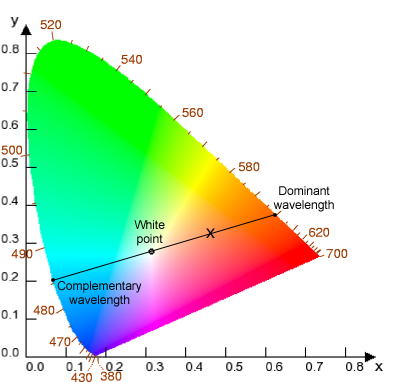Determination
Color space
Not all color spaces can be used for determining the dominant wavelength of a color, because in most approximately perceptually uniform color spaces (such as CIELAB, Oklab, CIECAM02, etc) two colors with the same hue can have slightly different dominant wavelengths. Unless otherwise stated, the CIE 1931 color space (CIEXYZ) is used., [3] but the CIELUV color space is sometimes used. [1] : 66 The LMS color space can also be used for this purpose.
Calculation
To calculate the dominant wavelength of a chromaticity (or color), a half straight line is drawn on the chromaticity diagram that passes through the chromaticity's coordinates and starts in the white point (almost always, illuminant E, which is the equal energy white point). The line is then extrapolated so it intersects the perimeter of the diagram at one point, where the perimeter comprises the spectral locus or the line of purples. The point of intersection of that line and the spectral locus is the dominant wavelength. [4] If the line intersects with the line of purples and not the spectral locus, the complementary wavelength is used. The purity can then be calculated as defined here. [1]
Complementary wavelength
When the chromaticity lies within the triangle with vertices at the white point, extreme spectral violet (360 nm), and extreme spectral red (780 nm), the dominant wavelength is indeterminate because the half straight line that passes through the white point and that chromaticity point intersects the limit of the visible gamut in the line of purples instead of the spectral locus. The colors on the line of purples cannot be defined by wavelength because they do not represent monochromatic light. [1]
Instead, the dominant wavelength is replaced with the complementary wavelength, which will represent the complementary color. To calculate it, the half straight line that starts on that chromaticity and passes through the white point is used; the intersection between this line and the spectral locus is the complementary wavelength. If a color doesn't have a dominant wavelength (and it is not achromatic), its complementary color will.
This page is based on this
Wikipedia article Text is available under the
CC BY-SA 4.0 license; additional terms may apply.
Images, videos and audio are available under their respective licenses.

